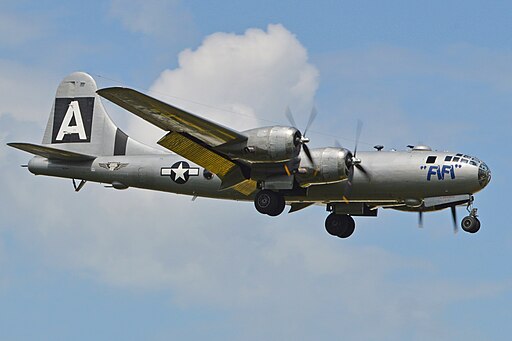In the history of aviation, the B-29 Superfortress stands out as a remarkable testament to human ingenuity and engineering prowess. Birthed in a time filled with technological breakthroughs, this iconic bomber stretched the limits of the conceivable, establishing unprecedented standards in terms of its performance, architectural sophistication, and overall capabilities. This exploration seeks to dissect the complex web of advanced features that positioned the B-29 as a juggernaut in the skies, leaving an unforgettable mark on the history of aerial warfare.
Engineering Elegance: The Vision Behind the B-29
The genesis of the B-29 Superfortress is a tale woven with ambition and ingenuity, capturing the spirit of an era engulfed in the crucible of global conflict. The aircraft emerged as a behemoth, embodying a sophisticated design philosophy that integrated pressurized cabins, remote-controlled gun turrets, and a robust wingspan. More than just a bomber, the B-29 was a floating citadel, poised to assert dominance in the aerial theater and instill trepidation in the enemy’s hearts.
Propulsion Prowess: The Heart of the Superfortress
Delving into the core of the B-29’s prowess, we find an unprecedented propulsion marvel. Four Wright R-3350 Duplex-Cyclone turbo-supercharged radial engines provided the heartbeat for this aerial giant, each delivering extraordinary power. This innovative propulsion ensemble granted the Superfortress a velocity that set it apart from its contemporaries. It was also an ability to soar at altitudes once considered unattainable for a bomber of its stature.
Navigational Nuances and Bombardment Precision
The B-29 Superfortress heralded a new epoch in aerial navigation and bombardment accuracy. Equipped with a state-of-the-art analog computer, the aircraft transformed the art of bombing, achieving a level of precision that was unparalleled. Its advanced radar systems and avionic wonders enabled navigational exactitude and bombing precision, ensuring the Superfortress’s place as an invaluable asset to the Allied forces.
Defensive Dexterity: A Floating Fortress
The defensive understanding of the B-29 was as impressive as its offensive capabilities. Remote-controlled gun turrets marked a paradigm shift in aerial defense, enhancing crew safety and firing accuracy. These turrets, managed through intricate analog computer systems, ensured that the Superfortress could fiercely defend itself against adversarial threats. Complemented by the addition of a pressurized cabin, the crew experienced a level of endurance and comfort unprecedented in long-haul missions.
Preserving Progress: The Legacy of the B-29
As the pages of history continue to turn, the B-29 Superfortress stands resilient, a beacon of progress and technological mastery. Its influence permeates, laying the groundwork for future generations of bombers and setting a lofty standard in aerial capability. Today, the preserved B-29s serve as tangible connections to this era of innovation, captivating imaginations and standing as monuments to a transformative period in aviation history.
Conclusion
The B-29 Superfortress, with its intricate web of advanced features and formidable capabilities, remains a shining example of engineering prowess and innovative spirit. From its powerful engines and sophisticated avionics to its unprecedented defensive systems, the Superfortress established itself as a technological tour de force. In paying homage to this remarkable chapter in aviation history, we celebrate the relentless pursuit of progress that gave birth to the B-29, ensuring its story continues to inspire and capture the imagination of future generations.
For more insights into the B-29 Superfortress and other important military aircraft, visit Aces In Action. Here, you’ll find an amazing piece of artwork by Craig Tinder titled “Thunderhead of Precision,” which illustrates the crew members of the 58th Bombardment Wing, 20th Air Force, and their final mission of World War II. The limited edition canvas print even includes a piece of relic originating from B-29 44-61975, making it a unique piece of history!
Thunderhead of Precision – B-29 Superfortress Aviation Art by Craig Tinder
14 August 1945 – Five days after the second and final atomic bomb was dropped on Japan, B-29 Superfortress bombers of the 58th Bombardment Wing, 20th Air Force carried out their final attack of the war. As part of an all-out effort to force Japan’s unconditional surrender, nearly 200 B-29s from the 58th struck the Hikari Naval Arsenal (target code: Thunderhead). The mission was considered one of the most precise bombing missions of WWII and included no B-29 losses. At noon the following day, Emperor Hirohito made a radio broadcast announcing Japan’s intention to surrender.






Share:
Soaring Through History: The Ki-61 Hien and Its Italian Legacy
TBM Avenger Legacy: Grumman, General Motors, and World War II Mobilization